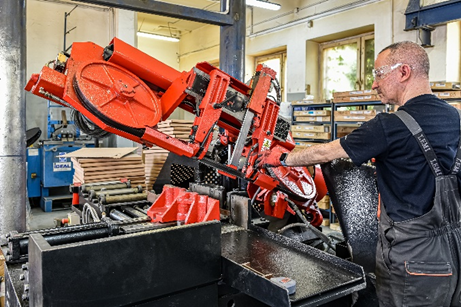

Manufacturers of agricultural machinery, trying to cope with growing market declines, are constantly focusing their activities on new ways of improving efficiency, which may involve searching for savings. One of the key steps in increasing efficiency is investing in high-quality metal processing tools – such as a band saw – and correct work with the new tool, which I will describe below. SWORD comes to help you properly use the new tool.
The SWORD company is a leader with an established position on the European tool market, whose core business is the production of band saws and accessories dedicated to the metal, food and wood industries, as well as the distribution of band saws from renowned manufacturers – AMADA and FMB. The motto of SWORD is quality and their products are covered by an unconditional satisfaction guarantee – which distinguishes them from other companies in the metal industry.

So what should you do with your new band saw?
The first step is to unroll the new band saw and attach it to the band saw. Then, properly tension the belt and move the movable guide as close as possible to the material to be processed. The last element is to set the brush to collect chips generated during the cutting process, to the depth of the tape notch. If we have completed the above procedure, proceed to the running-in procedure.
What is the importance of the break-in procedure?
First of all, it should be noted that the running-in procedure should be carried out in every possible case. Proper lapping of the tape will smooth and strengthen the cutting edges of the tape, which will reduce the risk of chipping the prong tips. Chipping of the tip of even one or several prong on the belt can lead to complete destruction of the prong in a short time – subsequent teeth of the belt will “make up” for cutting the material for the chipped prong, and the actuator will force feed jumps while the chipped prong are working.
Guidelines for belt lapping recommended by the SWORD Technical Department.
Easily cutable materials.
At cutting speeds above 50m/min. it is recommended that:
– reducing the cutting speed to approximately 70% of the target value
– feed speed up to approx. 50% of the target value.
Note: Feed reduction refers to the measured feed value, not the actuator adjustment indication, which means that 50% of the feed is to complete the cut in twice the target time.
Materials that are difficult to cut.
At cutting speeds below 50m/min. it is recommended that:
– reducing the cutting speed to approximately 80%-90% of the target value
– reducing the feed speed to approximately 50% of the target value.
Note: when cutting difficult-to-cut (solid) materials, the parameters set should result in the formation of chips (not dust). If this does not happen, the parameters should be adjusted – most often, the feed speed should be increased.
General recommendations.
If the cutting took place in normal conditions (without excessive noise), we begin to gradually increase the parameters. The lapping procedure should generally take place while cutting 200-400 cm² of material, but it may be shorter or longer depending on the tape length used, the material being cut or the parameters used.
Risk.
There should be no excessive vibration of the cutter during the lapping procedure. You should not allow a situation where the cutting speed is lower in relation to the feed speed – for example, 70% of the cutting speed, 90% of the feed speed – because such actions may lead to accelerated wear of the belt.
